Services on Demand
Article
Indicators
Related links
-
 Cited by Google
Cited by Google -
 Similars in Google
Similars in Google
Share
Lexikos
On-line version ISSN 2224-0039
Print version ISSN 1684-4904
Lexikos vol.30 Stellenbosch 2020
http://dx.doi.org/10.5788/30-1-1592
ARTICLES
A Critical Evaluation of Three Sesotho Dictionaries1
'n Kritiese evaluering van drie Sesotho woordeboeke
Mmasibidi SetakaI; D.J. PrinslooII
ISouth African Centre for Digital Language Resources, South Africa and University of Pretoria, Pretoria, South Africa (mmasibidi.setaka@nwu.ac.za)
IIDepartment of African Languages, University of Pretoria, Pretoria, South Africa (danie.prinsloo@up.ac.za)
ABSTRACT
This article gives a perspective on Sesotho lexicography and a critical analysis of the macrostructures and microstructures of three selected Sesotho dictionaries. The monolingual paper dictionary Sethantso sa Sesotho, the bilingual paper dictionary Southern Sotho-English Dictionary and the Sesotho online Bukantswe v.3 are evaluated. Their virtues and shortcomings as reference works will be viewed against dictionaries of high lexicographic achievement in order to establish to what extent they fulfil the most basic requirements of macrostructures and microstructures. The inconsistencies addressed in this article reflect the need for Sesotho lexicographers to use corpora in dictionary compilation in order to enhance the quality of entries on both microstructural and macro-structural levels. It will be argued that much more research and description of lexicographic issues is required to bring Sesotho lexicography on a par with its sister languages, Sepedi and Setswana and with good dictionaries for major languages of the world. After decades in existence, currently available Sesotho dictionaries are in dire need for revision and new dictionaries aimed at specific target users should be compiled.
Keywords: lexicography, dictionaries, sesotho, corpora, lemmatisation, LEMMA TREATMENT, CONCORDANCES, MICROSTRUCTURE, MACROSTRUCTURE
OPSOMMING
Hierdie artikel gee 'n perspektief op Sesotho-leksikografie en 'n kritiese ontleding van die makrostrukture en mikrostrukture van drie geselekteerde Sesotho woordeboeke. Die eentalige papierwoordeboek Sethantso sa Sesotho, die tweetalige papierwoordeboek Southern Sotho-English Dictionary en die Sesotho online Bukantswe v.3 word geëvalueer. Hulle deugde en tekortkominge as naslaanwerke sal beskou word teenoor woordeboeke van hoë leksikografiese gehalte om vas te stel in watter mate hulle aan die mees basiese vereistes van makrostrukture en mikrostrukture voldoen. Die teenstrydighede wat in hierdie artikel aangespreek word, weerspieël die noodsaaklikheid dat Sesotho leksikograwe korpora in woordeboeksamestelling gebruik om die gehalte van inskrywings op mikrostrukturele sowel as makrostrukturele vlak te verhoog. Daar sal geargumenteer word dat baie meer navorsing en beskrywing van leksikografiese kwessies nodig is om die leksikografie van Sesotho op gelyke voet te bring met die sustertale Sepedi en Setswana asook met goeie woordeboeke van wêreldtale. Na dekades van gebruik, moet die Sesotho woordeboeke wat tans beskikbaar is dringend hersien word en nuwe woordeboeke saamgestel word wat op spesifieke teikengebruikers gerig is.
Sleutelwoorde: leksikografie, woordeboeke, sesotho, korpora, lemmatisering, lemmabewerking, konkordansies, mikrostruktuur, makrostruk-tuur
1. Introduction
Sesotho lexicography receives very little attention in the literature, compared to e.g. its sister languages Sepedi and Setswana. For Sepedi, numerous studies have been done on problematic macrostructural and microstructural aspects such as lemma selection, treatment of lemmas and the utilisation of electronic corpora to enhance lexicographic quality. on the macrostructural level, most modern Sepedi and Setswana dictionaries utilise frequency counts from corpora as an aid to decide on inclusion or omission of lemmas for newly compiled or revised dictionaries. on the microstructural level, concordance lines culled from corpora contribute to quality enhancement in the writing of definitions, selection of translation equivalents, selection of examples, etc. De Schry-ver and Prinsloo (2000a) give a detailed discussion of the shortcomings in African language dictionaries on the macrostructural level due to inadequate lemma offerings, mostly as a result of including lemmas in the dictionary "as they cross the compiler's mind" rather than by means of a specific selection strategy such as frequency lists from corpora. African language dictionaries also do not perform well at the microstructural level due to inadequate treatment of the lemmas, as will be shown in more detail below. See also De Schryver and Prinsloo (2000b), Gouws and Prinsloo (2005) and Otlogetswe (2009a and b, 2012, 2013), for detailed discussions for Sepedi and Setswana. With the exception of Moleleki (1999), Prinsloo (2013), and Motjope-Mokhali (2016), no in depth lexicographic research has been recorded for Sesotho. A work of merit is Motjope-Mokhali's (2016) critical comparison of the Sesuto-English dictionary and Sethantso sa Sesotho with reference to lexical entries and dictionary design.
In this article we will focus on Sesotho lexicography and will explore and critically analyse one monolingual dictionary, Sethantso sa Sesotho (henceforth referred to as Sethantso), one bilingual, Southern Sotho-English Dictionary, (SSED) and an electronic dictionary, Sesotho Online Bukantswe v.3 (Bukantswe) in terms of their macrostructural and microstructural characteristics. Benchmarking the quality of these Sesotho dictionaries will be done against dictionaries of high lexicographic achievement on the basis of a number of basic requirements of macrostructures and microstructures.
2. Criteria for the evaluation of Sesotho dictionaries
Prinsloo and Taljard (2017: 428-430) give a detailed discussion of the problematic aspects of evaluation of macrostructures and microstructures of dictionaries for African languages. They state that any comparison between African language dictionaries with dictionaries deeply rooted in a long and rich lexicographical tradition is somewhat unfair. Ideally, specific types of dictionaries with narrowly defined target users should be compared with each other in terms of the specific quality criteria applicable to that specific type of dictionary. So, for example, a Sesotho monolingual dictionary for advanced learners should be compared with English monolingual dictionaries for advanced learners. None of the three Sesotho dictionaries evaluated in this article, however, has narrowly defined target users. They are all aimed at undefined target users and have to serve all possible user profiles. The researcher has no other option than to revert to an evaluation based upon the most basic criteria for the judgment of lexicographic quality of Sesotho dictionaries. Gouws (1990: 52) emphasizes that good dictionaries, as containers of knowledge, are characterised by their offering of a variety of information types. Macmillan Dictionary (MD) gives a concise summary of such basic requirements of a dictionary:
A dictionary is a description of the vocabulary of a language. It explains what words mean, and shows how they work together to form sentences. http://www.macmillandictionaries.com/features/from-corpus-to-dictionary/
Gouws and Prinsloo (2005: 144) say that "the word must be defined in such a way that the users will get all the answers to the questions that made him or her consult the dictionary".
Finding the word he/she is looking for in the dictionary and finding sufficient information about the meaning and use of the word relates to the compilation of the lemma list (as part of the macrostructure) and treatment of the lemma (data types in the microstructure).
3. A survey of Sesotho dictionaries
Sesotho dictionaries known to the authors are listed with brief descriptions of author, type and size, where available, in table 1. This survey of dictionaries is focused on general dictionaries which according to Nkomo (2010: 372) "... have a very important role to play in the development, acquisition and use of indigenous African languages". The sizes and scope of these dictionaries are different, as some are mere word lists while others provide more comprehensive treatment of the lemma.

4. Lemma selection and treatment
In this section the aim is to evaluate the macrostructures and microstructures of Sethantso, SSED and Bukantswe. The lemma lists and the treatment of lemmas in these dictionaries were evaluated based on introspection as well as through comparison with Sesotho corpora. The focus will be on the merits and contributions made to the knowledge of Sesotho, but a number of shortcomings on macrostructural and microstructural level will also be highlighted and briefly discussed. These presumed shortcomings revolve around (a) insufficient basic information in respect of meaning and translation equivalents, (b) alphabetical ordering, (c) morphological information, (d) pronunciation guidance, (e) examples of usage, (f) inconsistencies in the presentation and treatment of lemmas and (g) inadequate search functions.
4.1 Sethantso
This is a monolingual dictionary written in Lesotho Sesotho orthography and first published in 2005. It contains approximately 10,000 lemmas and the typical information given in the articles of each lemma includes paraphrase of meaning (a definition), part of speech, noun class indication and prefix of the plural form in the case of nouns, past tense derivation in the case of verbs and etymology as in figure 1. Basic orthographic differences between South African and Lesotho orthographies are SA di > Lesotho li, kg > kh, tjh > ch, fj > fsh, etc. See https://en.wikipedia.org/wiki/Sesotho_orthography for a detailed discussion and typical examples.

In the treatment of kamore 'room' the plural form is indicated in brackets as the final part of the lemma as (li.), i.e. the plural form is likamore 'rooms'. This is followed by part of speech indication given in italics between forward slashes indicating that it is a noun from class 9 followed by a definition and that it is borrowed from Afrikaans. The articles in this dictionary are relatively short - on average 32 articles per page in double columns. No examples of usage, collocations, pronunciation, etc. are given. In particular, examples of usage could be valuable in illustrating the different types of rooms and related terms, as has been successfully done in the English-Sesotho Dictionary (ESD) for the lemma room in figure 2.

The English-Sesotho Dictionary did well in giving a clear scope of different types of rooms by means of labelling them in brackets but still being economical, using only five lines of dictionary column space. Adding examples of use would assist users in text production and should be considered for future revisions of this dictionary. Consider the corpus lines for kamore in table 2.

The concordance lines in table 2 show the different types of rooms which ought to be put in the article to, help the user to understand the meaning of the word, its range of application and the opportunity to extract authentic examples of usage from the corpus as emphasized by De Schryver and Prinsloo (2000b). Such examples bring the meaning of different types of rooms to the fore and can be regarded as a natural extension of the definition. Future compilers of Sesotho dictionaries are advised to consult Sesotho corpora in the compilation of dictionaries to enhance the quality of their micro- and macrostructural compilations. Consider the value added by an example of usage of room in the Oxford Bilingual School Dictionary: Northern Sotho and English (ONSD) in figure 3.

In figure 3 the three-star markup (***) is a valuable indication to the user that room is a highly frequent word and such markup is often wisely perceived by learners as an implicit recommendation to not only find its meaning but also to learn such a word to extend their vocabulary of the language. The structural markers ■ and ♦ help to demarcate the different information categories, translation equivalents and examples, respectively. These markers also contribute to a user-friendly layout and are appealing to the eye.
Collocations could economically be indicated as part of examples to give an indication of words which more often than chance predicts co-occur with kamore 'room', thus giving users a clearer picture of its meaning.
One has to keep in mind that space is limited in single-volume paper dictionaries. Compilers often have to strike a balance between the number of entries that can be accommodated versus the exhaustiveness of the treatment. So, for example, Prinsloo (2009: 162) says the compiler is caught up in a triangulation of number of lemmas versus exhaustiveness of treatment versus price.
In principle, these limitations leave the compiler with two basic options: the inclusion of a large number (e.g., 20,000-30,000) of lemmas with limited (e.g., 1-2 lines double column) treatment, or a limited number (e.g., 10,000) of lemmas with more exhaustive (e.g., 5-7 line) treatment.
This is also true for Sesotho dictionaries.
Sesotho monolinguals should nevertheless strive towards giving a more detailed treatment of lemmas in order to meet the basic requirements as stated above in terms of MD and Gouws and Prinsloo (2005).
Consider example (1) as an attempt at a model entry for mala 'entrails'.
(1)
mala1(ma-la) 5/6 [mala]
Setho sa mmele se fumanwang ka mpeng ya motho kapa ka mpeng ya phoofolo se jarang dijo, ho di tsamaisa le ho di kenya maro a itseng a tsoang mabopong a ona. Dikgoho di na le mala a masesane. Batho bohle ba na le mala. Ke ja mala le mohodu. Mala a kgomo a maholo.
mala2
Lefu le tshwarang motho ha a dubehile ka mpeng, a jele dijo tse senyehileng kapa dijo di sa dula hantle ka mpeng. Ntate o tshwerwe ke mala. Mala a mmangwane a bohloko, ebile o a tsholla. Nthabiseng o sebedisitse mala. Ke tshwerwe ke mala. Mme o mathiswa ke mala.
mala3
Lela la pene. Pene ya Tshepo e na lela le le lelele. Dipene di na le mala a fapaneng. Enke e ka hara lela lena e omme.
In example (1) the three homonym distinctions are separated and indicated by superscript numbers. Syllable division, noun class singular/plural is given as well as a specific class indication, class 6 in this case, and a phonetic transcription. The class and class pair indication is done in a very economical way showing the relation 5/6 with the relevant one in this entry given in boldface.
Consider also the treatment of mala in figure 4, in the paper version for Sepedi, a sister language of Sesotho in Pukuntsutlhalosi ya Sesotho sa Leboa (PTLH) which is a reflection of a well-compiled article.

The treatment of mala in example (1) and figure 4 is more appropriate: it distinguishes between the different senses and it gives usage examples. It also indicates the different data categories - someone who does not understand Sesotho will perhaps not be able to distinguish the different categories. The absence of frequency indication in (1) indicates relatively low frequency. Examples of usage are clearly illustrated in bold and paraphrased in such a way that the user is able to understand the true meaning of mala.
On the level of the macrostructure the lemma offering of Sethantsho for the alphabetical stretch "L" was compared with words occurring more than 200 times in a Sesotho corpus of approximately 1.5 million words. Only non-derived words were taken into consideration as it cannot necessarily be expected from a dictionary to lemmatise nominal and verbal derivations. For example, a dictionary cannot be criticized if it lemmatises only the non-derived forms of frequently used words, (frequencies given in brackets), such as the verb stem lahla (729) 'lose, throw away' and the noun lebenkele (799) 'shop' and not any of their derivations. Typical derivations are verb stems containing verbal suffixes e.g. the perfect, applicative, passive and relative forms, or nouns occurring with locative, diminutive or augmentative suffixes. Consider, for example, the derived verb stems lahlile (215) (perfect) 'lost' and latelwang (251) (applicative + passive + relative) 'which is followed' as well as the locative derivation lebenkeleng (906) 'at the shop'. It would be user friendly if a dictionary did lemmatise frequently used derivations as has been done in ONSD. Lemmatisation of derivations, however, cannot be put as a requirement in this evaluation because the editorial policy of the dictionary could simply be not to lemmatise certain regularly derived forms of verbs and nouns. This is typically the approach for passive, perfect and locative forms irrespective of the frequency of the specific derivation, as in Pukuntsu (PUKU). Sethantso did, however, lemmatise a number of frequently derived words, e.g. lapile (281) 'hungry'. Consider table 3 for an edited list of these words compared to the lemma list of Sethantso.
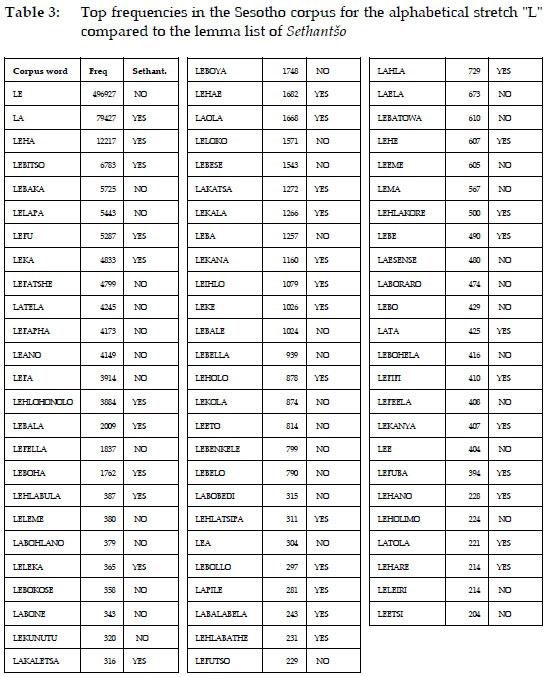
The lemma list of Sethantso does not compare well with the Sesotho words which occur more than 200 times in the Sesotho corpus. The dictionary lemma-tised and treated only 35 of the 75 i.e. 47% of these top frequencies that can be assumed to be words likely to be looked up especially by learners of the language. Common words such as lebaka (5,725) 'reason', Laboraro (474) 'Wednesday' and leano (4,149) 'a plan', are obviously missing. De Schryver and Prinsloo (2000c) suggest that compilers should do much better in the compilation of lemma lists on intuition. Compilers should at least be able to capture the most frequently used words in a language even without the help of frequency lists culled from corpora.
4.2 SSED
The Sesuto-English Dictionary was published in 1876 in Lesotho. Several editions followed. The 4th edition, enlarged by Dieterlin was published in 1911. In 1959 a revised and enlarged edition, the Southern Sotho-English Dictionary by Paroz was published. This edition was presented in the South African orthography (Moleleki 1999: 243). The edition under discussion in this article is the 8th edition of 1961.
SSED is a classic example of dictionaries that were not compiled through the use of corpora but on introspection over time by Mabille, Dieterlin and Paroz. Moleleki (1999: 243) regards SSED as "the most useful and consulted work for Sesotho". He, however, bluntly states that "the work is not user-friendly. It is structured by the presupposition that the user is very conversant with the structure of Sesotho". He is of the opinion that the dictionary is not meant for learners but for those who already have a sound competence in the language. Narrowing the target users down to users who have a sound basic knowledge of the grammar of Sesotho is fine in itself, and ideally dictionaries should be aimed at clearly defined target users (Gouws and Prinsloo 2005: 3). However, if a dictionary is the only significant available reference work for a specific language it has to serve by necessity the needs of the broader Sesotho-speaking community. This includes learners of the language who are mother-tongue speakers as well as non-mother-tongue speakers. It will be briefly argued in terms of Van Wyk (1995) below that this dictionary unnecessarily excludes users who do not have the required grammatical knowledge of Sesotho simply because it opted for bad choices in lemmatisation strategy and alphabetical ordering.
Consider the following typical examples of articles from SSED in figure 5.
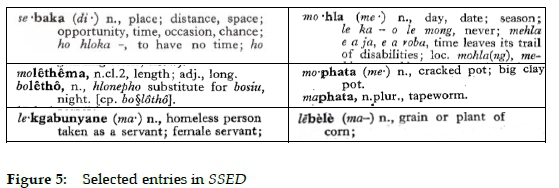
The entry sebaka in this extract is indicated as a noun with the translation equivalent paradigm 'place, distance, space, opportunity, time, occasion, chance'. The plural form is indicated in brackets as (di.). This is followed by several examples of usage e.g. ho hloka sebaka 'to have no time'. Nouns are lemmatised according to the first letter of the noun stem, thus the word lebele is lemmatised in the alphabetical stretch B on its stem form -bele and mohla under -hla. Likewise lekgabunyane is lemmatised under -kga, molethema and boletho under -le, and mophata and maphate under -pha. If the user wants to look up mohla 'day' in the SSED he/she won't find it under M because the user is supposed to know that, since a stem lemmatisation strategy is followed, the prefix mo- has to be removed and that it should be looked up on the stem under H, i.e. -hla. However, the lemma is not found under H in a normal alphabetical order. The alphabetical stretch H runs from stems beginning with ha-, hi-, ho-, ... hwi-but words starting with hl- are not listed - they are given under a following main stretch HL as mo.hla.
Van Wyk (1995), supported by Prinsloo and De Schryver (1999) and Prins-loo and Theletsane (2018), strongly argue against the use of stem lemmatisation for disjunctively written languages such as Sesotho. They argue that stem lemmatisation is unnecessary and unwanted for disjunctively written languages and that future compilers of paper dictionaries should stick to word lemmatisation. It simply means that instead of expecting the user to identify the stems -bele, -lethema, -kgabunyane, etc. as a prerequisite for look-up, the lexicographer could simply have lemmatised lebele and lekgabunyane under L, boletho under B and mohla, molethema, mophata and maphata under M. Van Wyk (1995) also dismisses all claims that stem lemmatisation is superior, more scientific and more economical than word lemmatisation.
Thus, we believe that for SSED changing from a word to a stem tradition in the 7th edition was a step in the wrong direction. In the front matter the motivation for changing to stem lemmatisation was the belief that the noun prefix is a mobile and exchangeable element (SSED: xii). Even this belief was refuted by Van Wyk (1995: 86) saying that "this assumption is, however, wrong; the morphology of the noun differs in crucial ways from that of the verb. The noun prefix is not mobile or freely exchangeable as Paroz claims".
SSED motivates its viewpoint with the example that motho 'a person' should be lemmatised on its stem form -tho in order to bring together words "which are similar in origin and related in meaning and of showing better the relative place of a given word in the language". This would hold true for motho 'person', batho 'people', setho 'culture' and botho 'mankind'. The resulting entry is given in figure 6 as two columns.
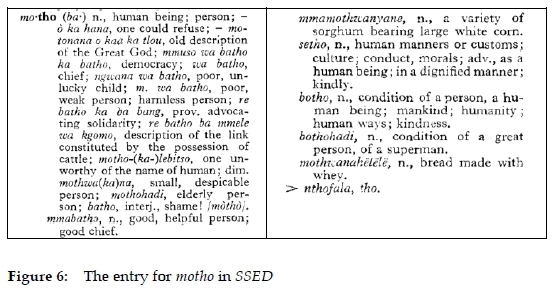
Since setho, botho, bothohadi, etc. are treated separately no significant space saving is achieved. The only real advantage is that no separate entry is required for the plural form batho, thus saving less than a single line in the dictionary article. Providing plural forms and their treatment as separate articles does require duplication of the treatment of the singular form. However, plural forms are handled in a very economic and effective way in ONSD by sacrificing one line for the lemma and a skeleton treatment thereof, with a cross-reference to the singular as in example (2).
(2) batho *** pl. noun 1/2 See sg. MOTHO
So, in ONSD the lemmas motho, batho, setho and botho can all be found alphabetically under their first letters by even inexperienced users who do not have any grammatical knowledge of the language.
A second drawback is the phonetic ordering of lemmas in SSED instead of an ordinary alphabetical ordering. Digraphs and trigraphs are treated as single letters in their own right instead of as two or three individual letters for alphabetical ordering, i.e. as a, b, c, (ch), d, e, f, fj, g, h, hl, i, j, k, kg, kh, l, m, n, nc, ng, nq, nx, ny, o, p, ph, pj, pjh, q, qh, r, s, sh, t, th, tj, tjh, tl, tlh, ts, tsh, u, v, w, x, (xh), y, z. This means that ordinary alphabetical categories are divided into different subsections. For example, T is split up into no less than eight categories e.g. t, th, tj, tjh, tl, tlh, ts and tsh. For example, th in a word such as thaba 'mountain' comes after tetetsa 'bruise, beat' separated by 24 dictionary pages where in the New South Sotho dictionary (NSSD) tetetsa and thaba are separated by a single entry. To the ordinary user who does not have in-depth phonetic knowledge, this arrangement is user-unfriendly, difficult to comprehend and simply does not make sense. This affects the alphabetical ordering of bigrams and trigrams inside words as well.
It can be concluded in terms of Van Wyk (1995), Prinsloo and De Schryver (1999) and Prinsloo and Theletsane (2018) that stem lemmatisation brings no gain but imposes an unnecessary burden on the user, - it makes it very difficult for especially the inexperienced user to find words. Exactly the same goes for a phonetic instead of an ordinary alphabetical ordering. When stem lemmatisation and phonetic ordering are combined it is even worse and even experienced users struggle to look up words in such dictionaries. They often have to revert to a guidance page, if provided, or can even incorrectly conclude that the word is not in the dictionary. Compilers of future Sesotho dictionaries should seriously consider abandoning both stem lemmatisation and a phonetic alphabetical ordering.
On the level of the macrostructure, the lemma list of SSED compares well with top frequencies in the Sesotho corpus as indicated in table 4.
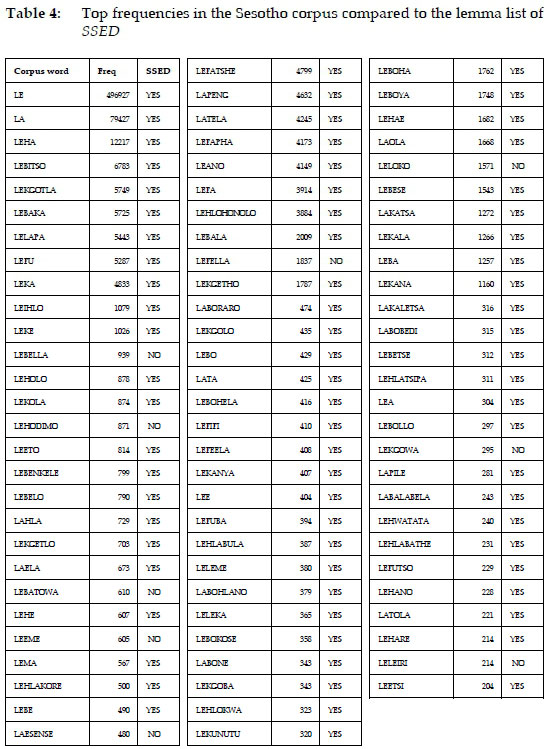
SSED lemmatised and treated 75 of the 84 words considered, i.e. 88%. In this case the compilers did well in the selection of top frequencies.
4.3 Bukantswe
It is generally believed that electronic dictionaries made a slow start, but will eventually supersede paper dictionaries in many ways.
Though 'electronic lexicography' - the use of digital media for delivering dictionary data - dates back at least as far as 1990, the pace of change has picked up dramatically in the last five years, after a leisurely start. (Rundell 2012: 72)
Good electronic dictionaries are characterised by the utilisation of electronic features enabled by computer technology and utilisation of virtually unlimited space on the internet. The interested reader is referred to De Schryver (2003), and Prinsloo (2019a) for a more detailed discussion of such features and to Bothma, Prinsloo and Heid (2018), Prinsloo, Prinsloo and Prinsloo (2018), Prinsloo (2019a), Prinsloo and Bothma (2020) and Prinsloo and Taljard (2019) for detailed discussions on user support tools in electronic dictionaries.
Bukantswe has more than 10,000 Sesotho entries with their English equivalents available from http://bukantswe.sesotho.org/. Searches can be done in English and Sesotho. In its self-description it is stated that Bukantswe is a "Bilingual English-Sesotho dictionary, [the] dataset represents a basic Sesotho dictionary compiled in the creation of a Sesotho language resource". The dictionary was developed by Jako olivier and is "based on an on line word list published and revised since 1996" (https://repo.sadilar.org/handle/20.500.12185/419).
At first glance when a user opens Bukantswe a search box is presented and users can start right away by typing in the word they are looking for. Consider figure 7 for the search word lapeng.
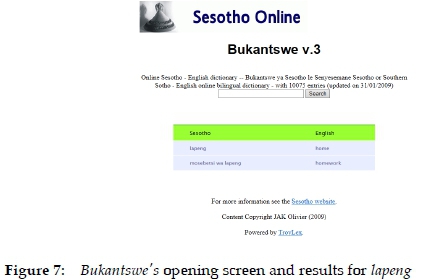
The user is informed about the size of the dictionary - it contains 10,075 entries. The current screen layout has been changed from the previous one which offered a clickable A-Z alphabetical option as in figure 8.
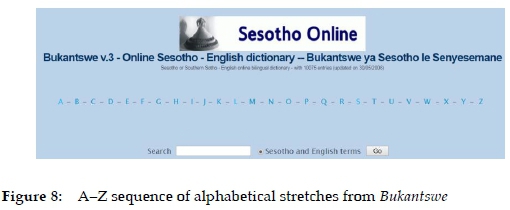
Bukantswe gives users translation equivalents of words and not any pronunciation guidance or examples of usage.
It is a virtue of the dictionary that noun classes and persons are indicated as in (3a-3d). It indicates singular forms of nouns with an "s.", followed by the class number in brackets and the same for plural forms with "pl." as in (3a). Class numbers and indication of first and second person singular and plural are also given for pronouns as in (3b-3d), but are missing in cases such as (3e) and (3f) where class indication as (s.9) and (pl.02) respectively should be given.
(3)
a. agente (s.9) diagente (pl.10) agent
b. Ana demonstrative pronoun (06) these
c. lohle all (05) (quantitative pronoun)
d. wena you (singular) (absolute pronoun)
e. kakaretso [1] abstract
f. badimo [1] ancestors
Part of speech (POS) is indicated for nouns (n.), verbs (v.), adjectives (adj.), pronouns (e.g. quantitative pronoun), etc. as in example (4)
(4)
karabo (s.9) dikarabo (pl.10) [1] answer (n.)
baleha flee (v.)
a matonana huge (06) (adj.)
ohle all (06) (quantitative pronoun)
bja slap (ideophone)
However, POS indication is not done consistently - consider the missing POS indication for nouns in (5a) and (5b) and missing indications for verbs in (5c) and (5d).
(5)
a. avenyu (s.9) diavenyu (pl.10) avenue
b. ketso (s.9) diketso (pl.10) [1] action
c. bipetsana suffocate
d. ntjhafatsa modify
The dictionary indicates etymology by means of a convention "(<="">" as in (6a). In this case it indicates that saena is derived from the English word sign. Nothing is inserted between the two double quotation marks. If, however, the origin is from another language, e.g. Afrikaans the original word or language is indicated between these two double quotation marks followed by a closed bracket as in (6b-6f). In (6b), for example, it is indicated that kalaka is borrowed from 'kalk'. The placement of the closed bracket directly after the Afrikaans word is unclear.
(6)
a. saena sign (v.) (<="">
b. kalaka lime (<="" kalk)="">
c. bora drill (v.) (<="" boor)="">
d. amen amen (<="" afr)="">
e. ankere (s.9) diankere (pl.10) anchor (<="" anker)="">
f. borashe ba terata wire brush (<="" draad)="" afr="">
Another virtue of Bukantswe is that homonyms are distinguished. Amohetse has three unrelated translations, 'accepted', 'accommodated' and 'adopted'. Homonym distinction is made by homonym numbers in square brackets following the lemma as in (7), indicating three unrelated meanings for amohetse. Homonym numbers are even supplied for translation equivalents as in (7b) but in such cases it merely looks like synonym paradigms, i.e. bjara and bjaratsa as translation equivalents of crush.
(7)
a. amohetse [1] accepted (v.)
amohetse [2] accommodated (v.)
amohetse [3] adopted (v.)
b. bjara crush (v.) [1]
bjaratsa crush (v.) [2]
Scientific and domain labels are used throughout the dictionary. Consider (8a) and (8b) for natural elements and (8d) for domain indication.
(8)
a. Aluminiamo Aluminium (Al) [Element]
b. Argone Argon (Ar) [Element]
c. bela boil (liquids) (v.)
d. Amose Amos (Biblical Name)
In (8) Aluminiamo and Argone are labelled as [Element] i.e. belonging to the periodic table of natural elements and Amose as a Biblical name in the religion domain. Such labels are valuable to the user to distinguish between words belonging to the general language versus words occurring in specific domains. So, for example, solution refers to the solving of a problem in the general language but is domain specific if referring to a chemical solution. A number of shortcomings were, however, noticed.
Users who want to look up frequently used words, e.g. mosadi (5,140) 'woman' and monna (7,191) 'man' find no results. In the case of monna the full string "monna (s.1) banna (pl.2) [2]" as search node is required; even searching for "monna (s.1) banna (pl.2)", i.e. without "[2]" renders no results. Exactly the same holds true for mosadi, i.e. searching for the full string "mosadi (s.1) basadi (pl.2) [3]" is required. This is a serious problem which existed at the time of consultation (December 2019-January 2020) and needs to be corrected urgently. As it stands the user would simply conclude that these top frequency items, monna and mosadi are not in the dictionary.
Another major problem is that the results obtained from the look-up often reflect partial-matches, i.e. mere blind data base hits instead of reflecting a dictionary article. For example, the result for the search of the second-most frequently used word in the Sesotho corpus, le (426,927) returns no less than 270 results of which (9) is an extract. It is clear that all words containing 'le' (boldfaced in (9)), either in Sesotho or English have simply been blindly extracted from the database.
(9)
tenehile irritated
teotsa ya pensele pencil sharpener
themperetjhara ya mmele body temperature
thomello dikerafike ho tswa ka ntle importing graphics
Thuto (lebitso) [1] Lesson (female name)
tsamaisa [2] lead (v.)
tsamaisa [3] let go (v.)
tsamaisa [4] let someone/something walk (v.)
The user who wants to know the meaning of the word le has to read through 270 unwanted entries and ironically, the most basic meanings of le 'and, with, also' are not given, with hammoho le 'together with' as the closest match. This probably represents the worst case of information overload - something that is frequently cautioned against in the literature, cf. Gouws and Tarp (2017).
Consider also the results for motho (23,052) 'person' in (10):
(10)
ha ho motho nobody
tidima ya tse jang motho pathologist
Not indicating the basic meaning 'human being, person' but giving 'pathologist' is completely illogical and misinforms the user.
From all of these examples it is clear that even for the correctly treated lemmas there are not much microstructural information or data types offered, as discussed in terms of Gouws and Prinsloo (2005) above. The information types are limited to a translation equivalent and hardly fulfil the basic requirements of a dictionary. The dictionary does not give any synonyms where applicable, no related words, no examples of usage, no pronunciation guidance, etc. Pronunciation guidance can be very effectively given in electronic dictionaries by means of clickable icons; see figure 10. These entries in Bukantswe are examples of what Prinsloo and Taljard (2017: 431) call "ontoereikende bewerking" (insufficient treatment) of the lemmas. Consider the information given for ja 'eat' in (11) compared to corpus extracts in table 5, SSED and ONSD in figure 9 and MD, figure 10 respectively. Insufficient treatment is unacceptable in electronic dictionaries because virtually unlimited space and true electronic features enabled by the computer are available, cf. Prinsloo (2019b) for a detailed discussion.
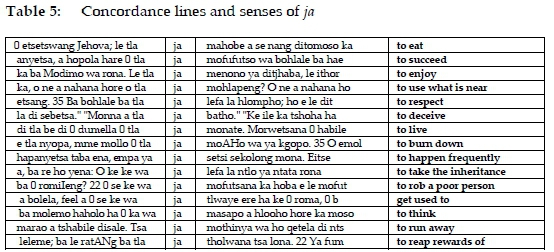

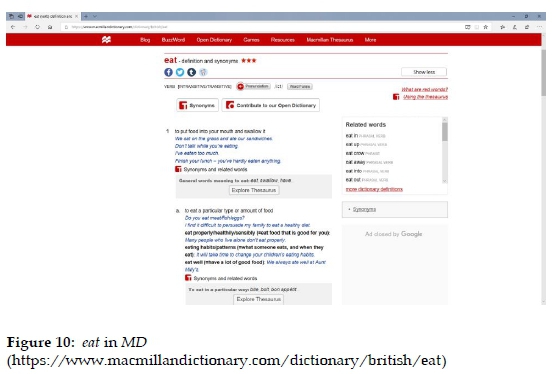
(11)
ja [1] eat (v.)
Prinsloo (2015) indicates the value of even a very limited corpus in the compilation of dictionaries. Corpus lines suggest a number of senses that can be distinguished for -ja. The boldfaced words in the final column in table 5 describe the sense in which the lemma -ja 'eat' has been used in the different lines.
Such corpus lines are invaluable to the lexicographer to distinguish the different senses of eat for consideration for inclusion in the dictionary. It often happens that lexicographers are alerted to senses that they might have missed if they had to rely on intuition only. It has to be realised, however, that not every single concordance line represents a different sense - it is the task of the lexicographer to decide on the number of senses to be distinguished.
The entry for ja in SSED, although not compiled using a corpus, as well as in ONSD is richer because it captures a number of senses through translation equivalents such as 'to eat' 'to despoil', 'to cost', 'to cause pain', 'to ache', etc.
The entry for eat in MD also indicates lexicographic richness of treatment.
In figure 10 a wealth of information types are given such as different senses, translation equivalents, examples of usage, frequency indication, pronunciation, word forms, definitions, etc. This is a good example of what future Seso-tho electronic dictionaries should look like.
A further shortcoming in Bukantswe is the lack of even a very basic user's guide to the dictionary.
On the level of the macrostructure, as indicated in table 6, the lemma list of Bukantswe does not compare well with top frequencies in the Sesotho corpus. This is aggravated by the presumed technical detection problem described above, i.e. cases where the dictionary gives look-up results only if the full string is entered. It simply means searches for hundreds, if not thousands of especially nouns will not render any results.

Bukantswe lemmatised and treated 19 of the 84 words considered i.e. 23% which reflects insufficient coverage of the selected top frequencies. Even without a corpus, the lexicographer is expected to capture a greater percentage of the most frequently used verbs on intuition as mentioned above in terms of De Schryver and Prinsloo (2000c).
5. Conclusion and future work
Sesotho lexicography is in a developing phase and much more research and description of lexicographic issues is required to bring the body of knowledge for this language on a par with its sister languages Sepedi and Setswana and lexicographic achievement of dictionaries for major languages of the world such as English, French, German, etc. The virtues and shortcomings raised in this article in respect of Sethantso, SSED and Bukantswe are a true reflection of most African language dictionaries. Gouws and Prinsloo (2005: 9) say that "the publication of any dictionary should not only be the result of the preceding compilation activities but it has to be regarded as the culmination of a much more comprehensive set of activities, the so-called lexicographic process". Furthermore, the inconsistencies addressed in this article reflect the need for Sesotho lexicographers to use corpora in dictionary compilation in order to enhance the quality of entries on both microstructural and macrostructural levels. Corpus utilisation will also enable compilers to indicate frequencies of words in the dictionary as has been done in ONSD by means of a 3-star rating system, as in figure 9 above. After decades in existence, currently available Sesotho dictionaries are in dire need for revision and new dictionaries aimed at specific target users should be compiled. A language cannot be served by only a few dictionaries compiled as a one-size-fits-all for user needs. Gouws and Prinsloo (2010: 505) state that no single dictionary can be everything for everyone. There is also a strong need for community involvement in the compilation of Sesotho dictionaries in a true Afro-centric approach where more mother-tongue speakers of Sesotho take the initiative to compile good Sesotho dictionaries, cf. Prinsloo (2017) and Prinsloo (2019b).
Acknowledgements
This research is supported in part by (a) the South African Centre for Digital Language Resources (SADiLaR) and (b) the National Research Foundation of South Africa (Grant specific unique reference number 85763). The Grant holder acknowledges that opinions, findings and conclusions or recommendations expressed in any publication generated by the NRF supported research are those of the authors, and that the sponsors accept no liability whatsoever in this regard.
Endnote
1 The term 'Bantu' got stigmatised during the Apartheid Era in South Africa. Therefore the term 'African' will be used in this article even in reference to what is internationally referred to as 'Bantu languages'.
Bibliography
Dictionaries
(Bukantswe) Sesotho Online, Bukantswe v.3. Available at http://bukantswe.sesotho.org/. [accessed: January 7, 2020].
(ESD) Motsapi, M. (Ed.). 2015. English-Sesotho Dictionary. Cape Town: South African Heritage Publishers. [ Links ]
(MD) Macmillan Dictionary. Available at http://www.macmillandictionaries.com/ [accessed: May 5, 2019].
(NSSD) Chaphole, S.R. 1997. New South Sotho Dictionary. English-South Sotho, South Sotho-English. Pietermaritzburg: Shuter & Shooter. [ Links ]
(ONSD) De Schryver, G.-M. (Ed.). 2007. Oxford Bilingual School Dictionary: Northern Sotho and English. Cape Town: OUP Southern Africa. [ Links ]
(PTLH) Mojela, M.V. (Ed.). 2007. Pukuntsutlhalosiya Sesotho sa Leboa. Pietermaritzburg: Nutrend. [ Links ]
(PUKU) Kriel, T.J. and E.B. van Wyk. 1989. Pukuntsu. Pretoria: J.L. van Schaik. [ Links ]
(Sethantso) Hlalele, B. 2005. Longman Sethantso sa Sesotho. Maseru: Longman Lesotho. [ Links ]
(SSED) Mabille, A. and H. Dieterlen. 1988. Southern Sotho-English Dictionary. Revised by R.A. Paroz. Morija: Morija Sesotho Book Depot. [ Links ]
Other
Bothma, T.J.D., D.J. Prinsloo and U. Heid. 2018. A Taxonomy of User Guidance Devices for e-Lexicography. Lexicographica. International Annual for Lexicography 33: 391-422. [ Links ]
De Schryver, G.-M. 2003. Lexicographers' Dreams in the Electronic-Dictionary Age International Journal of Lexicography 16(2): 143-199. [ Links ]
De Schryver, G.-M. and D.J. Prinsloo. 2000a. Electronic Corpora as a Basis for the Compilation of African-language Dictionaries. Part 1: The Macrostructure. South African Journal of African Languages 20(4): 291-309. [ Links ]
De Schryver, G.-M. and D.J. Prinsloo. 2000b. Electronic Corpora as a Basis for the Compilation of African-language Dictionaries. Part 2: The Microstructure. South African Journal of African Languages 20(4): 310-330. [ Links ]
De Schryver, G.-M. and D.J. Prinsloo. 2000c. (In)consistencies and the Miraculous Consistency Ratio of '(x 1.25)4 = x 2.44', A Perspective on Corpus-based versus Non-corpus-based Lemma-sign Lists. Paper presented at the Fifth International Conference of the African Association for Lexicography (AFRILEX), University of Stellenbosch, Stellenbosch, 3-5 July 2000.
Gouws, R.H. 1990. Information Categories in Dictionaries, with Special Reference to Southern Africa. Hartmann, R.R.K. (Ed.). 1990. Lexicography in Africa. Progress Reports from the Dictionary Research Centre Workshop at Exeter, 24-25 March 1989: 52-65. Exeter Linguistic Studies 15. Exeter: University of Exeter Press.
Gouws, R.H. and D.J. Prinsloo. 2005. Principles and Practice of South African Lexicography. Stellenbosch: AFRICAN SUN MeDIA. [ Links ]
Gouws, R.H. and D.J. Prinsloo. 2010. Surrogaatekwivalensie in tweetalige woordeboeke met spesifieke verwysing na zero-ekwivalensie in Afrikataalwoordeboeke. [Surrogate Equivalence in Bilingual Dictionaries with Special Reference to Zero-equivalence in Dictionaries for African Languages]. Tydskrif vir Geesteswetenskappe 50(4): 502-519. [ Links ]
Gouws, R.H. and S. Tarp. 2017. Information Overload and Data Overload in Lexicography. International Journal of Lexicography 30(4): 389-415. [ Links ]
Moleleki, M.A. 1999. The State of Lexicography in Sesotho. Lexikos. 9: 241-247. [ Links ]
Motjope-Mokhali, Tankiso Lucia. 2016. A Comparative Analysis of Sesuto-English Dictionary and Sethantso sa SeSotho with Reference to Lexical Entries and Dictionary Design. Unpublished doctoral thesis. Pretoria: UNISA. Available at URI: http://hdl.handle.net/10500/22205.
Nkomo, D. 2010. Affirming a Role for Specialised Dictionaries in Indigenous African Languages. Lexikos. 20: 371-389. [ Links ]
Otlogetswe, T.J. 2009a. English-Setswana Dictionary. Second edition. Pentagon Publishers: Gaborone.
Otlogetswe, T.J. (Ed.). 2009b. MLA Kgasa: A Pioneer Setswana Lexicographer. CASAS Book series 64. Cape Town. CASAS. [ Links ]
Otlogetswe, T.J. 2012. Tlhalosi ya Medi ya Setswana. Gaborone: Medi Publishing. [ Links ]
Otlogetswe, T.J. 2013. Oxford English-Setswana, Setswana-English School Dictionary. Oxford: OUP. [ Links ]
Prinsloo, D.J. 2009. Current Lexicography Practice in Bantu with Specific Reference to the Oxford Northern Sotho School Dictionary. International Journal of Lexicography 22(2): 151-178. [ Links ]
Prinsloo, D.J. 2013. Lexicography of the Sotho Languages. Gouws, R.H., U. Heid, W. Schweickard and H.E. Wiegand (Eds.).. 2013. Dictionaries: An International Encyclopedia of Lexicography. Supplementary Volume: Recent Developments with Focus on Electronic and Computational Lexicography: 929-946. Handbücher zur Sprach- und Kommunikationswissenschaft/Handbooks of Linguistics and Communication Science. HSK Vol. 5.4. Berlin/Boston: Mouton de Gruyter. [ Links ]
Prinsloo, D.J. 2015. Corpus-based Lexicography for Under-resourced Languages - Maximizing the Limited Corpus. Paper read at AELINCO 2015, 7th Conference on Corpus Linguistics, Valladolid, Spain, 5-7 March 2015.
Prinsloo, D.J. 2017. Analyzing Words as a Social Enterprise: Lexicography in Africa with Specific Reference to South Africa. Miller, J. (Ed.). 2017. Analysing Words as a Social Enterprise: Celebrating 40 Years of the 1975 Helsinki Declaration on Lexicography. Collected Papers from AustraLex 2015: 42-59. https://www.adelaide.edu.au/australex/publications/.
Prinsloo, D.J. 2019a Detection and Lexicographic Treatment of Salient Features in e-Dictionaries for African Languages. International Journal of lexicography. ecz031, https://doi.org/10.1093/ijl/ecz031. Published: 27 November 2019.
Prinsloo, D.J. 2019b A Perspective on the Past, Present and Future of Lexicography with Specific Reference to Africa. Gürlek, Mehmet, Ahmet Naim Çiçekler and Yasin Tagdemir. 2019. Proceedings of the 13th International Conference of the Asian Association for Lexicography, ASIA-LEX 2019, 19-21 June 2019, Istanbul University Congress and Culture Center, Istanbul Turkey: 148-160. Istanbul: Asos.
Prinsloo, D.J. and T.J.D. Bothma. 2020. A Copulative Decision Tree as a Writing Tool for Sepedi. South African Journal of African Languages 40(1): 85-97. [ Links ]
Prinsloo, D.J. and G.-M. de Schryver. 1999. The Lemmatization of Nouns in African Languages with Special Reference to Sepedi and Cilubà. South African Journal of African Languages 19(4): 258-275. [ Links ]
Prinsloo, D.J., J.V. Prinsloo and Daniel Prinsloo. 2018. African Lexicography in the Internet Era. Pedro A. Fuertes-Olivera (Ed.). 2018. The Routledge Handbook of Lexicography: 487-502. London: Routledge. [ Links ]
Prinsloo, D.J. and E. Taljard. 2017. Afrikataalleksikografie: Gister, vandag en môre [African Language Lexicography: Yesterday, Today and Tomorrow]. Lexikos 27: 427-456. [ Links ]
Prinsloo, D.J. and E. Taljard. 2019. The Sepedi Helper Writing Assistant: A User Study. Language Matters 50(2): 73-99. [ Links ]
Prinsloo, D.J. and T. Theletsane. 2018. Stem Lemmatization and Phonetic Ordering of Lemmas in Sotho Dictionaries from a User Perspective. Conference Booklet of the 23rd International Conference of Afrilex, University of the Western Cape, Cape Town, South Africa. 27-29 June 2018: 40-42. Available online at https://afrilex.africanlanguages.com/AFRILEX%202018%20Booklet.pdf?timestamp=1578114060000.
Rundell, M. 2012. 'It Works in Practice but Will it Work in Theory?' The Uneasy Relationship between Lexicography and Matters Theoretical. Vatvedt Fjeld, Ruth and Julie Matilde Tor-jusen (Eds.). 2012. Proceedings of the 15th Euralex International Congress, 7-11 August 2012, Oslo: 47-92. Oslo: Department of Linguistics and Scandinavian Studies, University of Oslo.
Van Wyk, E.B. 1995. Linguistic Assumptions and Lexicographical Traditions in the African Languages. Lexikos 5: 82-96. [ Links ]














